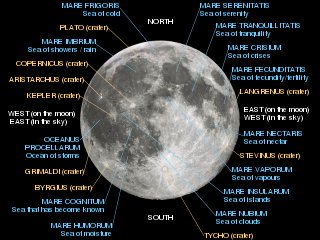
Messier is a relatively young lunar impact crater located on the Mare Fecunditatis. The crater has a discernible oblong shape that is not caused by foreshortening. The longer dimension is oriented in an east–west direction.

Carlini is a small lunar impact crater located in the Mare Imbrium. It was named after Italian astronomer Francesco Carlini. The crater is bowl-shaped with a small central floor. It has a higher albedo than the surrounding mare, making it prominent due to its isolated location. To the south is a wrinkle ridge named Dorsum Zirkel, and farther south lies the peak Mons La Hire.
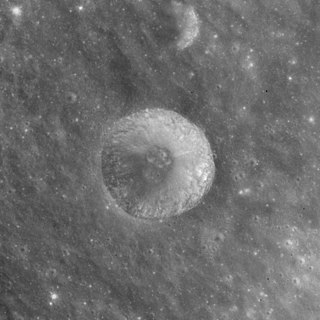
Acosta is a small lunar impact crater located just to the north of the prominent crater Langrenus, near the east edge of Mare Fecunditatis. To the west are the trio of Atwood, Naonobu, and Bilharz. Acosta is named after the Portuguese naturalist Cristóvão da Costa.

Bohnenberger is a lunar impact crater that lies near the east edge of the Mare Nectaris, in the foothills of the Montes Pyrenaeus mountain range that forms the perimeter of the mare. To the east beyond the mountains is the larger crater Colombo. The crater has a low rim along the north wall, and the floor is somewhat irregular with a ridge crossing the floor. There is a small crater along the western inner wall.
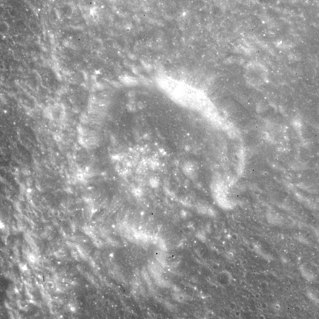
Secchi is a small lunar impact crater formation on the northwest edge of Mare Fecunditatis. It was named after the 19th-century Italian astronomer Angelo Secchi. To the northeast is the crater Taruntius. The western rim is joined with a section of the minor Montes Secchi range. The rim of this crater has been opened in the northern and southern ends, leaving two curved ridges facing each other across the crater floor. To the south is a pair of rilles designated the Rimae Secchi. These lie near the edge of the mare, and have a combined length of about 40 kilometers.

Abel is an ancient lunar impact crater that lies near the southeast limb of the Moon's near side. It is located to the south of the crater Barnard, at the northwest edge of the Mare Australe.

Appleton is a heavily eroded lunar impact crater that lies in the northern hemisphere on the far side of the Moon. To the northwest are the craters Von Neumann and Campbel. The smaller Golovin lies to the northeast, while further to the southwest is the Mare Moscoviense.

Archytas is a lunar impact crater that protrudes into the northern edge of Mare Frigoris. To the northwest is the comparably sized crater Timaeus, and the smaller Protagoras lies in the opposite direction to the southeast. Further to the southwest, beyond the opposite edge of the mare, is the dark-floored crater Plato.
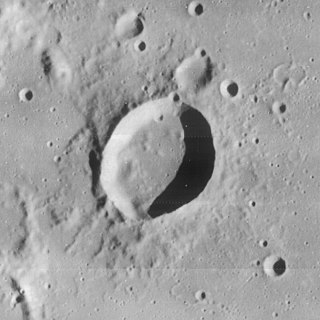
Clausius is a lunar impact crater that is located in the southwest part of the Moon, in the small lunar mare designated Lacus Excellentiae. It is completely enclosed by mare material, although the tiny satellite crater Clausius A lies just to the north. The rim of Clausius is low and sharp, with a slightly oval shape that is longer in the north-south direction. The interior floor has been flooded by basaltic lava, and appears level and featureless with a darker surface that matches the mare surface that surrounds the crater exterior.

Barbier is a lunar impact crater that is located on the southern hemisphere on the far side of the Moon. It forms a matched pair with Cyrano to the north-northwest, and it lies to the southeast of the huge walled plain Gagarin. Southwest of Barbier is the crater Sierpinski, and to the southeast is the Mare Ingenii.
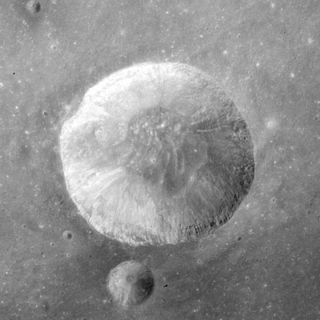
Carmichael is a lunar impact crater that is located along the eastern edge of the Sinus Amoris, in the northeastern quadrant of the Moon's near side. Its diameter is 20 km. It was named after American psychologist Leonard Carmichael. It lies within a couple of crater diameters south-southwest of the smaller crater Hill. Further to the east-northeast is the prominent crater Macrobius. Carmichael was designated Macrobius A before being given its current name by the IAU.

Damoiseau is a lunar impact crater that is located just to the west of the Oceanus Procellarum, in the western part of the Moon's near side. It lies due east of the prominent crater Grimaldi, a walled plain with a distinctive dark floor. Due south of Damoiseau is the crater Sirsalis.

Crozier is a lunar impact crater that is located on the southwest edge of Mare Fecunditatis, a lunar mare in the eastern part of the Moon's near side. It lies to the east-northeast of the prominent crater Colombo, and southeast of the small crater Bellot.

Elmer is a small lunar impact crater that is located to the south of Mare Smythii, near the eastern limb of the Moon. This crater is seen at a highly oblique angle from Earth, and the visibility is affected by libration. Elmer lies southwest of the crater Kreiken, and east-southeast of the larger Dale. This is a circular, bowl-shaped crater with an interior floor that occupies about half the total diameter.

Ibn Battuta is a small lunar impact crater on the Mare Fecunditatis, a lunar mare in the eastern part of the Moon's near side. It lies to the southwest of the crater Lindbergh, and northeast of the prominent Goclenius.
Bliss is small lunar impact crater that is located just to the west of the dark-floored crater Plato. It lies in a region of continental terrain between Mare Imbrium to the south and Mare Frigoris to the north. This crater is bowl-shaped, with a small interior floor at the midpoint and a somewhat eroded outer rim.

Couder is a small lunar impact crater that is located just behind the western limb of the Moon, in a region of the surface that is brought into view during favorable librations. It lies on the inner foothills of the Montes Cordillera, a ring-shaped mountain range that surrounds the Mare Orientale impact basin.

Chalonge is a lunar impact crater that is located on the far side of the Moon. It lies to the southwest of the larger crater Lewis, in the outer skirt of ejecta that surrounds the Mare Orientale impact basin. To the southeast are the Montes Cordillera, a ring of mountains that encircle the Mare Orientale formation.

Donner is a lunar impact crater on the far side of the Moon. It is located just to the northeast of the Mare Australe, behind the southeastern limb of the Moon. During favorable librations this part of the lunar surface can be brought into view of the Earth, but the site is viewed from the edge and so not much detail can be seen.

Fridman is the remains of a lunar impact crater on the far side of the Moon. It lies due south of the huge walled plain Hertzsprung, and is attached to the northeastern rim of the crater Ioffe.






